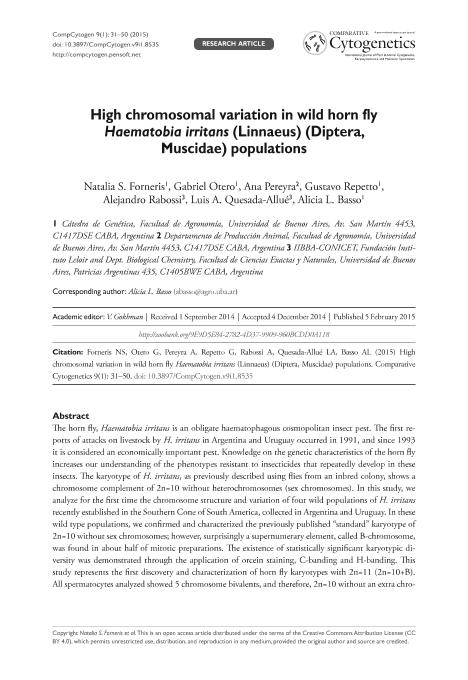Artículo
High chromosomal variation in wild horn fly Haematobiairritans (Linnaeus) (Diptera, Muscidae) populations
Forneris, Natalia Soledad ; Otero, Gabriel; Pereyra, Ana; Repetto, Gustavo; Rabossi, Alejandro
; Otero, Gabriel; Pereyra, Ana; Repetto, Gustavo; Rabossi, Alejandro ; Quesada Allue, Luis Alberto
; Quesada Allue, Luis Alberto ; Basso, Alicia L.
; Basso, Alicia L.
 ; Otero, Gabriel; Pereyra, Ana; Repetto, Gustavo; Rabossi, Alejandro
; Otero, Gabriel; Pereyra, Ana; Repetto, Gustavo; Rabossi, Alejandro ; Quesada Allue, Luis Alberto
; Quesada Allue, Luis Alberto ; Basso, Alicia L.
; Basso, Alicia L.
Fecha de publicación:
02/2015
Editorial:
Zoological Inst
Revista:
Comparative Cytogenetics
ISSN:
1993-0771
Idioma:
Inglés
Tipo de recurso:
Artículo publicado
Clasificación temática:
Resumen
The horn fly, Haematobiairritans is an obligate haematophagous cosmopolitan insect pest. The first reports of attacks on livestock by Haematobiairritans in Argentina and Uruguay occurred in 1991, and since 1993 it is considered an economically important pest. Knowledge on the genetic characteristics of the horn fly increases our understanding of the phenotypes resistant to insecticides that repeatedly develop in these insects. The karyotype of Haematobiairritans, as previously described using flies from an inbred colony, shows a chromosome complement of 2n=10 without heterochromosomes (sex chromosomes). In this study, we analyze for the first time the chromosome structure and variation of four wild populations of Haematobiairritans recently established in the Southern Cone of South America, collected in Argentina and Uruguay. In these wild type populations, we confirmed and characterized the previously published "standard" karyotype of 2n=10 without sex chromosomes; however, surprisingly a supernumerary element, called B-chromosome, was found in about half of mitotic preparations. The existence of statistically significant karyotypic diversity was demonstrated through the application of orcein staining, C-banding and H-banding. This study represents the first discovery and characterization of horn fly karyotypes with 2n=11 (2n=10+B). All spermatocytes analyzed showed 5 chromosome bivalents, and therefore, 2n=10 without an extra chromosome. Study of mitotic divisions showed that some chromosomal rearrangements affecting karyotype structure are maintained as polymorphisms, and multiple correspondence analyses demonstrated that genetic variation was not associated with geographic distribution. Because it was never observed during male meiosis, we hypothesize that B-chromosome is preferentially transmitted by females and that it might be related to sex determination.
Palabras clave:
Karyotypes
,
Genetic Variability
,
Population Genetics
,
C-Banding
Archivos asociados
Licencia
Identificadores
Colecciones
Articulos(IIBBA)
Articulos de INST.DE INVEST.BIOQUIMICAS DE BS.AS(I)
Articulos de INST.DE INVEST.BIOQUIMICAS DE BS.AS(I)
Articulos(OCA PQUE. CENTENARIO)
Articulos de OFICINA DE COORDINACION ADMINISTRATIVA PQUE. CENTENARIO
Articulos de OFICINA DE COORDINACION ADMINISTRATIVA PQUE. CENTENARIO
Citación
Forneris, Natalia Soledad; Otero, Gabriel; Pereyra, Ana; Repetto, Gustavo; Rabossi, Alejandro; et al.; High chromosomal variation in wild horn fly Haematobiairritans (Linnaeus) (Diptera, Muscidae) populations; Zoological Inst; Comparative Cytogenetics; 9; 1; 2-2015; 31-50
Compartir
Altmétricas



